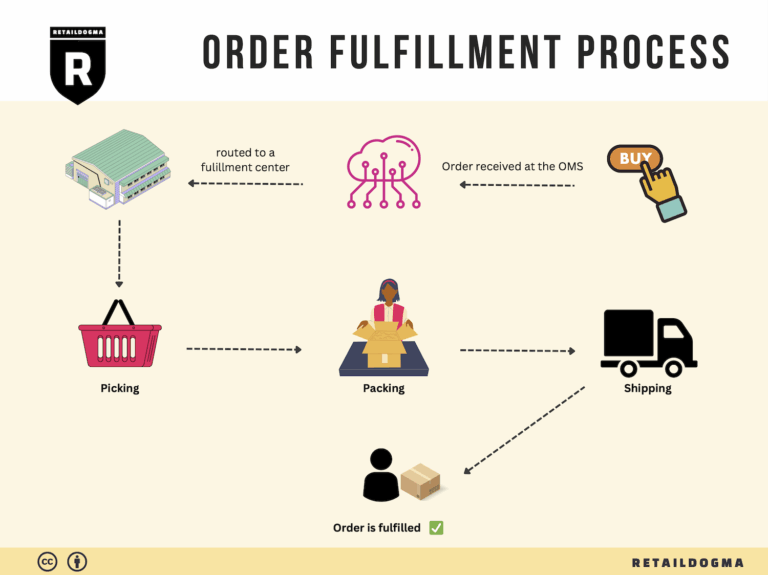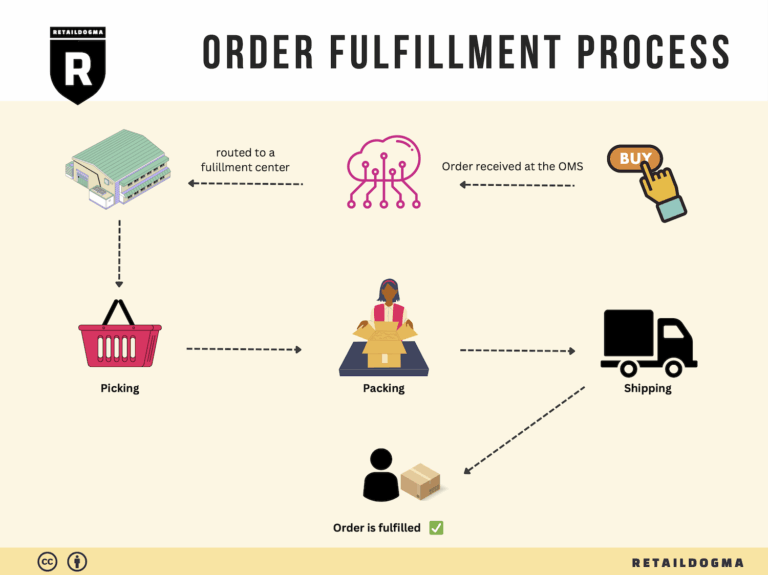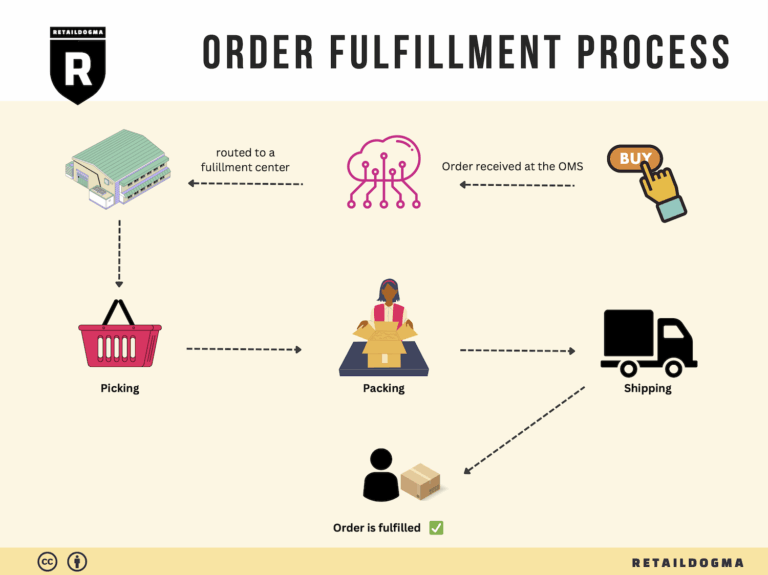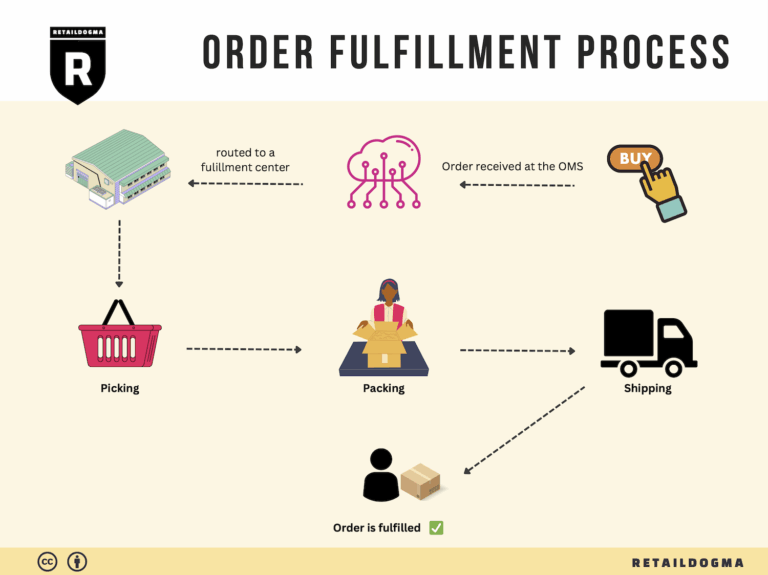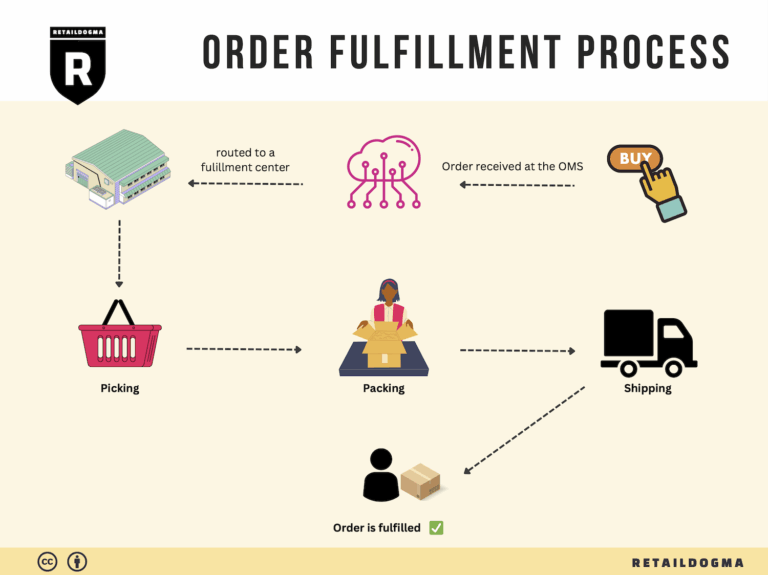How Order Fulfillment Works: A Step-by-Step Guide for Businesses
What is E-commerce Fulfillment? An Introduction for Growing Businesses
The Challenge of Packing and Shipping Orders
As an e-commerce business owner, you may find yourself in a familiar predicament: overwhelmed by the logistics of packing and shipping orders. While the excitement of growing sales is exhilarating, the operational demands that come with it can quickly become burdensome. From managing inventory to ensuring timely deliveries, the fulfillment process can feel like a daunting task that takes precious time away from strategic growth initiatives.
Understanding E-commerce Fulfillment
At its core, e-commerce fulfillment refers to the entire process of delivering a product to a customer after they place an order online. This encompasses a range of critical activities, including receiving and storing inventory, processing orders, picking and packing items, and finally shipping them to the customer’s destination. Each of these steps plays a crucial role in ensuring a smooth transaction and customer satisfaction.
What This Guide Covers
In this comprehensive guide, we will explore various fulfillment models, including Third-Party Logistics (3PL) providers and Fulfillment by Amazon (FBA), to help you determine which option best suits your business needs. We will break down the core services involved in the fulfillment process, such as inventory management, order processing, and returns management, giving you insights into how these elements interconnect.
Moreover, we will provide practical advice on how to choose the right fulfillment partner. Factors such as technology capabilities, shipping options, and pricing will be crucial in making your decision. Understanding the costs associated with fulfillment is vital for budgeting and ensuring that your operations remain profitable.
Empowering Your Business Decisions
The goal of this guide is to empower you, the business owner, to make informed decisions about your logistics strategy. By understanding the intricacies of e-commerce fulfillment, you can better navigate the complexities of order management and shipping, ultimately leading to improved customer satisfaction and business growth. With the right knowledge and resources, you can turn fulfillment from a pain point into a strategic advantage that propels your business forward.
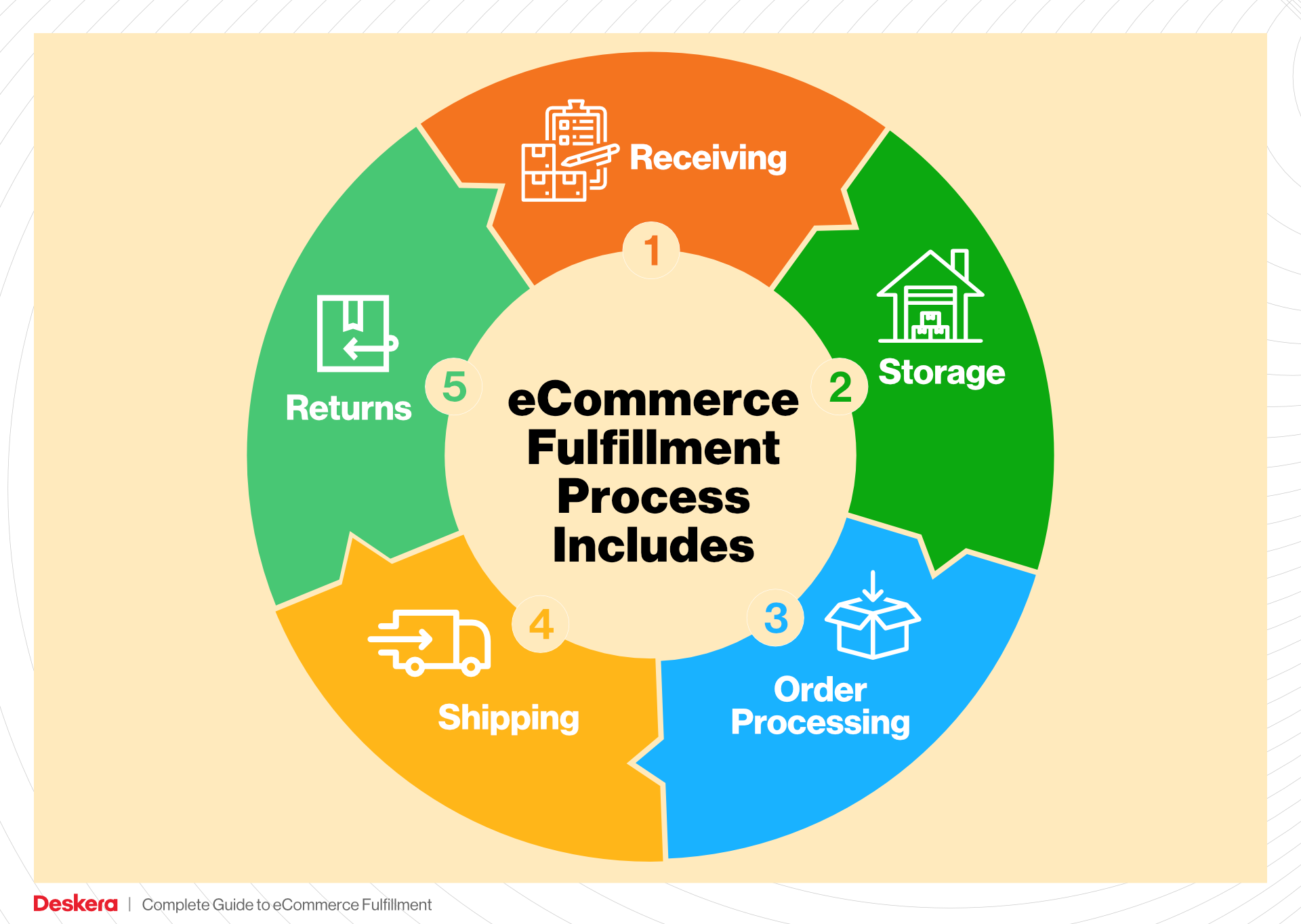
What You’ll Learn In This Guide
- What is E-commerce Fulfillment? An Introduction for Growing Businesses
- The Order Fulfillment Process: From ‘Buy’ Button to Customer’s Door
- Comparing Fulfillment Models: In-House vs. 3PL vs. Dropshipping
- A Deep Dive into Amazon FBA: Pros, Cons, and Who It’s For
- Core Services Offered by Fulfillment Centers
- How to Choose a Fulfillment Partner: A 6-Point Checklist
- Understanding Fulfillment Pricing: A Breakdown of Common Fees
- Frequently Asked Questions (FAQs) about Fulfillment
- Conclusion: Is Outsourcing Fulfillment the Right Move for Your Business?
- Important Disclaimer
The Order Fulfillment Process: From ‘Buy’ Button to Customer’s Door
1. Receiving Inventory
The order fulfillment process begins with receiving inventory, which involves the acceptance and verification of products from suppliers. Upon arrival at the fulfillment center, each shipment is checked against purchase orders to ensure accuracy. This step is crucial because it establishes the foundation for inventory management and ensures that the correct items are available for future orders.
During this phase, products are assigned unique identifiers, such as Stock Keeping Units (SKUs), which help in tracking inventory throughout the fulfillment process. This systematization prevents errors and discrepancies that can lead to stockouts or overstock situations, both of which can adversely affect customer satisfaction and cash flow. Efficient receiving processes set the stage for streamlined operations and ultimately contribute to meeting customer expectations.
2. Warehouse Storage
Once inventory is received and verified, the next step is warehouse storage. This involves placing products in designated storage areas within the fulfillment center, organized systematically for easy access. Effective warehousing is paramount as it impacts the speed and efficiency of subsequent fulfillment processes.
Utilizing a Warehouse Management System (WMS) can greatly enhance this stage. A WMS allows businesses to optimize space utilization, manage stock levels, and facilitate real-time inventory tracking. Proper storage practices reduce the time it takes to locate and retrieve products during order fulfillment, directly impacting delivery speed. Additionally, organized storage helps in maintaining inventory accuracy and reduces the likelihood of misplaced items, which can lead to fulfillment errors.
3. Order Picking
Order picking is the process of selecting items from the warehouse to fulfill customer orders. This step is critical as it directly affects order accuracy and efficiency. When an order is placed, a pick list is generated, detailing the items required for that order, along with their storage locations.
Efficient picking strategies, such as batch picking or wave picking, can significantly enhance productivity. Batch picking allows workers to pick multiple orders at once, while wave picking organizes orders into manageable groups based on shipping schedules. By optimizing picking processes, businesses can minimize the time spent locating and gathering items, which is essential for meeting customer expectations for fast delivery.
4. Order Packing
After items have been picked, they move on to the packing stage. This involves securely packaging products to protect them during transit and ensuring they arrive at the customer’s door in pristine condition. Proper packing is vital not only for customer satisfaction but also for minimizing returns due to damage.
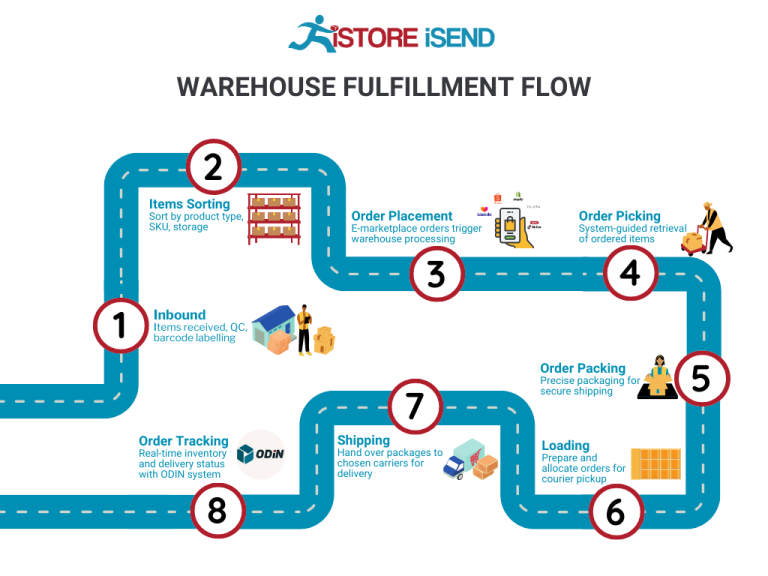
During this phase, businesses should consider using packing slips, which include order details and return instructions, to enhance the customer experience. Additionally, implementing a packing checklist can help ensure that all items are included and correctly packaged. Efficient packing processes contribute to faster shipping times and reduced shipping costs, as well-packaged orders are less likely to incur damages or require reshipment.
5. Shipping & Delivery
The final step in the order fulfillment process is shipping and delivery. This step encompasses the transportation of packaged orders from the fulfillment center to the customer’s designated address. It is critical to choose the right shipping carriers and options to meet customer expectations for delivery speed and cost.
Key factors influencing shipping decisions include shipping zones, which determine costs based on distance, and delivery options such as expedited shipping or free shipping thresholds. Leveraging partnerships with fulfillment providers can offer access to bulk shipping rates, allowing businesses to pass savings on to customers. Additionally, implementing tracking systems can enhance transparency and improve customer satisfaction by providing real-time updates on order status.
In conclusion, mastering the order fulfillment process is essential for e-commerce success. By understanding and optimizing each step—from receiving inventory to shipping and delivery—businesses can improve operational efficiency, reduce costs, and ultimately enhance customer satisfaction. Investing in technology and partnering with reliable fulfillment providers can further streamline these processes, enabling growth and scalability in a competitive market.
Comparing Fulfillment Models: In-House vs. 3PL vs. Dropshipping
Fulfillment Model Comparison Table
| Model | Who Handles Inventory | Best For (Business Stage) | Key Advantage | Key Disadvantage |
|---|---|---|---|---|
| In-House Fulfillment | The business itself | Startups to Established Brands | Full control over inventory and processes | High overhead costs and scalability challenges |
| Third-Party Logistics (3PL) | A specialized fulfillment provider | Growing to Established Brands | Access to expertise, technology, and economies of scale | Less control over inventory and potential service variability |
| Dropshipping | The supplier | Startups and Small Businesses | Minimal upfront investment and risk | Lower profit margins and reliance on supplier reliability |
In-House Fulfillment
In-house fulfillment refers to the process where an e-commerce business manages all aspects of order fulfillment within its own facilities. This model provides businesses with complete control over their inventory, processes, and customer experience. It is often favored by startups and established brands that have sufficient resources and wish to maintain a direct hand in their logistics operations. The primary advantage of in-house fulfillment is the ability to customize processes according to specific business needs, ensuring quality control and brand consistency. However, this model comes with significant disadvantages, including high overhead costs related to warehousing, staffing, and equipment. Additionally, as order volumes grow, scaling the operation can be challenging, requiring substantial investment in infrastructure and resources.
Third-Party Logistics (3PL)
Third-party logistics, or 3PL, involves outsourcing the fulfillment process to a specialized provider that manages storage, picking, packing, and shipping of products on behalf of the e-commerce business. This model is particularly advantageous for growing businesses that need to scale operations quickly without the burden of managing physical inventory and logistics. 3PL providers typically have advanced technology, established processes, and relationships with shipping carriers, which can lead to cost savings and faster delivery times. However, businesses may face challenges with this model, such as reduced control over inventory and potential variability in service quality. It’s essential for businesses to choose a reputable 3PL partner that aligns with their operational goals and customer expectations to mitigate these risks.
Dropshipping
Dropshipping is a fulfillment model where the e-commerce retailer does not hold inventory but instead relies on suppliers to ship products directly to customers after an order is placed. This model is particularly appealing for startups and small businesses due to its low upfront investment and minimal risk. Entrepreneurs can offer a wide variety of products without the need for warehousing or managing inventory. However, dropshipping often comes with lower profit margins since retailers typically pay wholesale prices to suppliers. Additionally, reliance on suppliers for inventory management can lead to issues with stock availability and shipping times, which can negatively impact customer satisfaction. To succeed with dropshipping, businesses must carefully vet suppliers and maintain clear communication to ensure reliable service and product quality.
Conclusion
Choosing the right fulfillment model is crucial for e-commerce businesses looking to scale. Each model—In-House Fulfillment, Third-Party Logistics (3PL), and Dropshipping—has its own set of advantages and disadvantages that should be carefully considered based on the company’s current stage, resources, and long-term goals. By understanding these differences, business owners can make informed decisions that align with their operational strategies and customer expectations, ultimately driving growth and improving service delivery.
A Deep Dive into Amazon FBA: Pros, Cons, and Who It’s For
Understanding Fulfillment by Amazon (FBA)
Fulfillment by Amazon (FBA) is a service that allows e-commerce sellers to store their products in Amazon’s fulfillment centers. Amazon takes care of storage, packaging, shipping, and customer service for these products, enabling sellers to leverage Amazon’s extensive logistics network and customer base. With FBA, sellers can focus on other aspects of their business, such as marketing and product development, while Amazon handles the logistics of order fulfillment.
How FBA Works
-
Setup: Sellers create an Amazon seller account and enroll in FBA. They list their products on Amazon and indicate that they want to use FBA for order fulfillment.
-
Inventory Management: Sellers send their inventory to Amazon’s designated fulfillment centers. Amazon provides guidelines on packaging and labeling to ensure products are ready for storage and shipping.
-
Storage: Once received, products are stored in Amazon’s warehouses. Sellers can monitor their inventory levels through their Amazon seller dashboard.
-
Order Fulfillment: When a customer places an order for an FBA product, Amazon picks, packs, and ships the item directly to the customer. Amazon also handles any customer inquiries or issues related to the order.

-
Returns Management: Amazon manages returns for FBA products, processing returns and handling customer refunds as necessary.
-
Multi-Channel Fulfillment: Sellers can also use FBA to fulfill orders from other sales channels, such as their own websites or other marketplaces, enhancing their operational efficiency.
Pros of Using FBA
-
Prime Eligibility: Products fulfilled by Amazon are eligible for Amazon Prime, which attracts a larger customer base. Prime members often prefer Prime-eligible items due to faster shipping options, increasing the chances of sales.
-
Customer Trust: Leveraging Amazon’s brand reputation enhances customer trust. Shoppers are more likely to purchase products fulfilled by Amazon, knowing they will receive their orders promptly and have reliable customer service support.
-
Multi-Channel Fulfillment: FBA allows sellers to fulfill orders from various sales channels, not just Amazon. This flexibility means sellers can streamline their logistics while reaching customers across multiple platforms.
-
Scalability: FBA makes it easier for businesses to scale. As demand increases, sellers can send more inventory to Amazon without needing to manage additional warehousing and logistics.
-
Time Savings: By outsourcing order fulfillment to Amazon, sellers can focus on other critical areas of their business, such as marketing, product development, and customer engagement.
Cons of Using FBA
-
High Fees: FBA comes with various fees, including storage fees (charged monthly based on the space your products occupy) and fulfillment fees (charged per unit sold). These costs can add up quickly and significantly impact profit margins, especially for low-priced items.
-
Strict Inventory Rules: Amazon has stringent guidelines regarding inventory management, including limits on the quantity of certain products that can be sent to their warehouses. Sellers must be diligent about maintaining compliance to avoid penalties.
-
Commingling Risks: FBA products from different sellers may be stored together, leading to potential issues with inventory management. If a customer receives the wrong item, it can result in negative feedback, returns, and damage to seller reputation.
-
Limited Control: By using FBA, sellers relinquish some control over their inventory and shipping processes. Any issues that arise from Amazon’s fulfillment centers—like delays or stockouts—are ultimately the seller’s responsibility.
-
Returns Management: While Amazon handles returns, the process can sometimes be cumbersome. Sellers may face challenges in tracking returns and managing inventory effectively, particularly with returned items that cannot be resold.
Who is FBA Best For?
Fulfillment by Amazon is an excellent option for various types of e-commerce businesses, particularly:
-
Small to Medium-Sized Sellers: Businesses that lack the infrastructure or resources to manage their own fulfillment can benefit from FBA’s extensive logistics network.
-
Brands Seeking Growth: Sellers looking to scale quickly and reach a broader audience can leverage FBA’s capabilities to boost visibility and sales, especially if they aim to target Amazon’s vast customer base.
-
Sellers with High Turnover Products: Products that sell quickly can benefit from FBA’s efficient order processing and shipping, allowing sellers to maintain a steady flow of sales without logistical bottlenecks.
-
Multi-Channel Retailers: Businesses that sell across various platforms can streamline their operations by using FBA for all their fulfillment needs, reducing complexity and improving efficiency.
-
Brands Seeking Trust and Credibility: Sellers looking to build brand trust and improve customer service can take advantage of Amazon’s reputation and customer service capabilities.
In conclusion, while FBA presents numerous advantages such as increased sales potential and operational efficiency, it also comes with challenges that require careful consideration. E-commerce businesses should evaluate their specific needs, product types, and sales strategies to determine if Fulfillment by Amazon aligns with their growth objectives.
Core Services Offered by Fulfillment Centers
Inventory Management & Warehousing
Inventory management and warehousing are foundational services provided by fulfillment centers, crucial for the smooth operation of e-commerce businesses. Inventory management involves tracking and overseeing the stock levels of products, ensuring that the right amount of inventory is available to meet customer demand without overstocking. This balance is essential to avoid cash flow issues associated with excess inventory and missed sales opportunities due to stockouts.
Fulfillment centers utilize advanced inventory management systems (IMS) that allow businesses to gain real-time visibility into their inventory levels. These systems help in forecasting demand, setting reorder points, and managing multiple SKUs across various locations. By outsourcing inventory management to a fulfillment center, e-commerce businesses can focus on strategic growth initiatives rather than day-to-day inventory oversight.
The warehousing aspect provides a secure and organized environment for storing products until they are needed for fulfillment. Fulfillment centers are designed to optimize space and streamline the storage process, making it easy to retrieve items quickly. This efficient warehousing capability ensures that orders can be processed faster, ultimately enhancing customer satisfaction by meeting delivery expectations.
Pick and Pack Services
Pick and pack services are integral to the fulfillment process, comprising the activities of selecting the ordered items from inventory (picking) and preparing them for shipment (packing). Once an order is placed, fulfillment centers employ systematic processes to accurately pick the right products and package them securely for delivery.
The benefits of efficient pick and pack services are manifold. First, they significantly reduce the time taken to fulfill orders, allowing e-commerce businesses to offer quicker shipping options, which is increasingly demanded by consumers. Additionally, fulfillment centers utilize technology, such as barcode scanning and automated picking systems, to minimize errors during the picking process. This accuracy not only enhances customer satisfaction by ensuring that the correct items are shipped but also reduces costly returns associated with incorrect orders.
Moreover, fulfillment centers often provide customizable packing options, enabling businesses to create a branded unboxing experience. This attention to detail can enhance customer loyalty and drive repeat purchases, as consumers appreciate a thoughtful and professional presentation of their orders.
Kitting and Assembly
Kitting and assembly are specialized services offered by fulfillment centers that involve bundling individual items into a single package or preparing products for sale. This can include creating gift sets, promotional bundles, or assembling components into a final product ready for sale.
For e-commerce businesses, kitting and assembly can provide significant advantages. First, it allows for the efficient management of complex orders, where multiple items need to be grouped together. This service streamlines the fulfillment process, as fulfillment centers can handle the labor-intensive tasks associated with assembling products, freeing up internal resources for other critical functions.
Additionally, kitting can enhance the perceived value of products by offering customers attractive bundles or unique combinations that may not be available elsewhere. This can lead to increased average order values and improved customer satisfaction, as shoppers appreciate the convenience of having multiple related items packaged together. Furthermore, it allows businesses to introduce seasonal or promotional items quickly without the need for extensive reconfiguration of their inventory management systems.
Returns Management (Reverse Logistics)
Returns management, also known as reverse logistics, is a crucial service that addresses the process of handling returned items. This includes receiving returned products, assessing their condition, restocking them if possible, and managing the customer’s refund or exchange process. The returns process can be complex and challenging for e-commerce businesses, making a well-structured returns management system essential.
Fulfillment centers streamline the returns process by implementing efficient workflows and dedicated systems for handling returns. This ensures that returned items are processed quickly and accurately, minimizing delays in issuing refunds or exchanges. By managing returns effectively, businesses can enhance customer satisfaction, as customers appreciate a hassle-free returns experience.
Moreover, effective returns management can provide valuable insights into product performance and customer preferences. By analyzing return data, businesses can identify patterns, such as common reasons for returns or products that consistently underperform. This information can inform inventory decisions, product development, and marketing strategies, ultimately leading to better business outcomes.
In conclusion, partnering with a fulfillment center that offers these core services—inventory management and warehousing, pick and pack services, kitting and assembly, and returns management—can significantly enhance an e-commerce business’s operational efficiency. By leveraging these services, businesses can focus on growth and customer satisfaction, ensuring they remain competitive in an increasingly demanding market.
How to Choose a Fulfillment Partner: A 6-Point Checklist
Location & Warehouse Network
Importance:
The location of your fulfillment partner’s warehouses is critical to minimizing shipping costs and delivery times. A strategically placed network of warehouses can significantly enhance your customer experience by ensuring faster delivery, especially if you cater to a wide geographic area.
Questions to Ask:
– How many fulfillment centers do you operate, and where are they located?
– Can you provide shipping estimates based on my typical order destinations?
– Do you have the ability to open additional locations if my business expands?
Technology & Integrations
Importance:
In today’s digital-first marketplace, your fulfillment partner’s technology stack can make or break your operational efficiency. A robust fulfillment platform should seamlessly integrate with your e-commerce site, inventory management system, and other tools to provide real-time data and insights.
Questions to Ask:
– What software do you use for order management and inventory tracking?
– Can your platform integrate with my e-commerce system (e.g., Shopify, WooCommerce)?
– Do you offer real-time tracking for both myself and my customers?
Specializations (e.g., Cold Storage, Oversized Items)
Importance:
Not all fulfillment centers are equipped to handle every type of product. If your business deals with specialized items—such as perishables, oversized products, or hazardous materials—ensure that your fulfillment partner has the necessary capabilities and certifications.
Questions to Ask:
– What types of products do you specialize in fulfilling?
– Do you have specific facilities for handling temperature-sensitive items?
– How do you manage compliance with regulations for specialized products?
Scalability & Capacity
Importance:
Your fulfillment partner should be able to accommodate your growth. Whether you anticipate seasonal spikes in demand or long-term scaling, it’s essential to know that your partner can handle increased volume without compromising service quality.
Questions to Ask:
– What is your current capacity, and how do you manage increased order volume during peak seasons?
– How quickly can you scale operations if my order volume increases?
– What systems do you have in place to ensure consistent fulfillment quality as we grow?
Pricing and Contracts
Importance:
Understanding the pricing structure and contract terms is vital to avoid unexpected costs and ensure your fulfillment partner aligns with your budget. Transparent pricing can help you manage your overall logistics costs effectively.
Questions to Ask:
– Can you provide a breakdown of your pricing model (e.g., per order, per item, storage fees)?
– Are there any additional fees I should be aware of (e.g., setup fees, packaging fees)?
– What are the terms of your contract, and is there flexibility in scaling my services?
Customer Support & Reviews
Importance:
Effective customer support is crucial for resolving issues quickly and maintaining operational flow. Additionally, reviews from other clients can provide insights into the reliability and quality of service you can expect from your fulfillment partner.
Questions to Ask:
– What support channels do you offer (e.g., phone, email, chat)?
– How quickly can I expect a response to inquiries or issues?
– Can you provide references or case studies from businesses similar to mine?
By evaluating potential fulfillment partners against these six criteria, you can make a more informed decision that aligns with your business goals and customer expectations. A strong partnership in fulfillment can drive efficiency, customer satisfaction, and ultimately, revenue growth.
Understanding Fulfillment Pricing: A Breakdown of Common Fees
Initial Setup Fees
When partnering with a fulfillment provider, businesses often encounter initial setup fees. These are one-time charges associated with establishing your account and integrating your systems with the fulfillment center’s technology. The setup process usually includes onboarding, configuring inventory management systems, and training on how to use the fulfillment provider’s platform effectively.
Calculation: Initial setup fees can vary significantly based on the provider and the complexity of your needs. Typically, these fees range from $500 to $2,000. To get a precise quote, inquire about the specific services included in the setup, such as custom integrations, training sessions, and any additional software configurations.
Receiving Fees
Receiving fees are charged when the fulfillment center takes possession of your inventory. This fee covers the labor and resources involved in unloading, inspecting, and storing the products. Proper receiving processes ensure that the items are in good condition and accurately recorded in the inventory system.
Calculation: Receiving fees are generally calculated per pallet or per hour, depending on the provider’s structure. For example, a provider might charge $25 per pallet received or $50 per hour for labor. To avoid unexpected costs, clarify how the receiving process works and what conditions may affect the fee, such as discrepancies in shipment quantities or damaged goods.
Storage Fees (per pallet/bin)
Storage fees are incurred for keeping your inventory at the fulfillment center. These fees can be calculated on a per-pallet or per-bin basis, depending on how the fulfillment provider organizes their storage. Storage fees can vary based on the location of the warehouse and the volume of inventory stored.
Calculation: Storage fees typically range from $10 to $50 per pallet per month. Some providers may also offer tiered pricing, where the cost per pallet decreases as you store more pallets. It’s essential to understand the minimum storage duration and any additional charges for overage or peak season storage, as these can impact overall fulfillment costs.
Pick & Pack Fees (per item/order)
Pick and pack fees are charged for the services involved in retrieving items from storage and preparing them for shipment. This includes picking the correct products, packing them securely, and labeling the packages for shipping. Efficient pick and pack processes are crucial for timely order fulfillment and customer satisfaction.
Calculation: Pick and pack fees are usually calculated per item or per order, with rates typically ranging from $1 to $3 per item or $3 to $10 per order. The complexity of the order can affect these fees; for example, orders with multiple SKUs might incur higher charges. To optimize costs, consider consolidating orders where possible and discuss with your provider any available discounts for high-volume orders.
Shipping Fees
Shipping fees encompass the costs associated with transporting the packaged products to customers. These fees can vary widely based on factors such as package dimensions, weight, shipping distance, and the selected carrier. A fulfillment provider often negotiates shipping rates with carriers due to their shipping volume, allowing businesses to benefit from discounted rates.
Calculation: Shipping fees are generally calculated based on weight and dimensions, along with the chosen shipping speed (standard, expedited, etc.). It’s common for providers to offer a shipping rate calculator or tools to estimate costs. For accurate projections, inquire about the specific carriers used, service levels offered, and any additional surcharges that may apply, such as fuel surcharges or residential delivery fees.
Tips for Getting an Accurate Quote
-
Be Transparent About Your Needs: Provide potential fulfillment partners with detailed information about your inventory, order volume, and specific fulfillment requirements. This helps them tailor their quotes to your unique situation.
-
Request Itemized Quotes: Ask for a breakdown of all fees involved, including setup, receiving, storage, pick and pack, and shipping. An itemized quote allows you to compare different providers effectively.
-
Consider Seasonal Variations: If your business experiences seasonal fluctuations, discuss how the provider handles peak season pricing and storage. Some providers may have different rates or policies during busy periods.
-
Evaluate Additional Services: Inquire about any value-added services that may be beneficial, such as returns management, kitting, or custom packaging. Understanding these options can help you assess the overall value of the fulfillment service.
-
Negotiate Terms: Don’t hesitate to negotiate fees or request discounts for long-term commitments or higher volume orders. Many fulfillment providers are open to discussions that can lead to mutually beneficial agreements.
By understanding these common fulfillment pricing models and how to navigate them, e-commerce businesses can make informed decisions that help optimize their logistics and ultimately enhance customer satisfaction.
Frequently Asked Questions (FAQs) about Fulfillment
1. What is a fulfillment distribution center?
A fulfillment distribution center is a specialized warehouse that handles the storage, processing, and shipping of e-commerce orders. Unlike traditional warehouses, fulfillment centers are designed to facilitate the entire order fulfillment process, including inventory management, picking, packing, and shipping products directly to customers.
2. What’s the difference between a warehouse and a fulfillment center?
The primary difference lies in their purpose. A warehouse is primarily focused on storing goods for an extended period, while a fulfillment center is optimized for processing and shipping orders quickly. Fulfillment centers are equipped with technology and processes that enable fast order processing, efficient inventory management, and direct shipping to customers.
3. What is a 3PL?
A Third-Party Logistics (3PL) provider is a company that offers outsourced logistics services, including warehousing, fulfillment, and shipping. By partnering with a 3PL, e-commerce businesses can leverage the provider’s infrastructure, technology, and expertise to streamline their supply chain and improve order fulfillment efficiency.
4. How much do fulfillment services cost?
Fulfillment service costs can vary significantly based on factors such as order volume, the complexity of the products, shipping destinations, and the specific services required. Common cost components include storage fees, picking and packing fees, shipping costs, and additional services like returns management. It’s essential to request quotes from multiple providers to compare pricing and understand the total cost of fulfillment.
5. How does the order fulfillment process work?
The order fulfillment process typically involves several steps:
1. Receiving Inventory: Products are received and stored in the fulfillment center.
2. Order Processing: Once an order is placed, the system triggers the fulfillment process.
3. Picking: Staff or automated systems retrieve the ordered items from inventory.
4. Packing: Items are packed securely for shipment, often using branded packaging.
5. Shipping: Orders are shipped to the customer using the selected carrier.
6. Returns Management: If necessary, the fulfillment center manages returns and reintegrates items into inventory.
6. What technology is used in fulfillment centers?
Fulfillment centers utilize various technologies to enhance efficiency and accuracy, including Warehouse Management Systems (WMS), Inventory Management Software (IMS), and automation tools like conveyor systems and robotics. These technologies help streamline operations, provide real-time inventory tracking, and improve order processing times.
7. How can I choose the right fulfillment provider?
Selecting the right fulfillment provider involves considering several factors:
– Services Offered: Ensure they can meet your specific fulfillment needs.
– Technology: Look for providers with robust technology for inventory management and order processing.
– Location: Choose a provider with fulfillment centers close to your customer base to reduce shipping times and costs.
– Experience and Reputation: Research their track record and read customer reviews.
– Cost Structure: Understand their pricing model and ensure it aligns with your budget.
8. Can I manage returns effectively with a fulfillment center?
Yes, most fulfillment centers offer returns management services that streamline the returns process. They can handle the receipt, assessment, and reintegration of returned items into inventory, ensuring a smooth experience for both the customer and the business. It’s crucial to understand the specific returns process of your fulfillment provider to optimize this aspect of your operations.
9. How can fulfillment impact customer satisfaction?
Effective fulfillment directly influences customer satisfaction by ensuring fast, accurate, and reliable delivery of orders. Meeting or exceeding customer expectations in shipping speed, order accuracy, and handling returns can lead to repeat purchases and positive word-of-mouth referrals. A well-managed fulfillment operation helps build trust and loyalty with your customers.
10. What are the benefits of outsourcing fulfillment?
Outsourcing fulfillment offers several advantages:
– Scalability: Easily adapt to changing order volumes without the need for significant capital investment.
– Cost Savings: Benefit from bulk shipping rates and reduced overhead costs associated with warehousing and staffing.
– Focus on Core Business: Free up time and resources to focus on marketing, product development, and customer engagement.
– Access to Expertise: Leverage the knowledge and experience of fulfillment professionals to optimize your logistics strategy.
Conclusion: Is Outsourcing Fulfillment the Right Move for Your Business?
The Case for Outsourcing Fulfillment
As e-commerce continues to evolve, the demands on businesses to meet customer expectations for fast, accurate, and affordable shipping have never been greater. Outsourcing fulfillment can be a game-changer for e-commerce businesses looking to scale. By partnering with a professional fulfillment service, you can save valuable time, allowing you to focus on core business strategies rather than the complexities of logistics. This time-saving aspect is crucial for entrepreneurs and operations managers who need to allocate resources efficiently.
Scalability is another significant advantage of outsourcing fulfillment. As your business grows, so do your shipping needs. A reliable fulfillment partner provides the infrastructure and expertise to handle increased order volumes without compromising service quality. This flexibility allows you to expand into new markets or channels with confidence, knowing that your fulfillment operations can keep pace with your growth.
Moreover, leveraging the expertise of a fulfillment provider can lead to enhanced operational efficiency. These companies specialize in logistics, offering advanced technologies, streamlined processes, and established relationships with carriers that can reduce shipping costs. This expertise translates into better inventory management, faster order processing, and improved customer satisfaction—key factors that drive repeat business.
However, the choice of fulfillment partner is critical. Not all providers offer the same level of service or capabilities. It’s essential to conduct a thorough audit of your current shipping process and assess whether a fulfillment partner aligns with your business goals and customer expectations.
Call to Action
Take the next step in your growth journey by evaluating your current fulfillment strategy. Ask yourself: Are you meeting customer expectations efficiently? Could a fulfillment partner enhance your operations? Conducting this audit could illuminate opportunities for improvement and help you determine if outsourcing fulfillment is the strategic move your business needs.
Important Disclaimer
⚠️ Important Disclaimer
The information in this guide is for educational purposes. Fulfillment services, pricing, and platform features change frequently. Always conduct your own due diligence and consult with providers directly before making business decisions.

